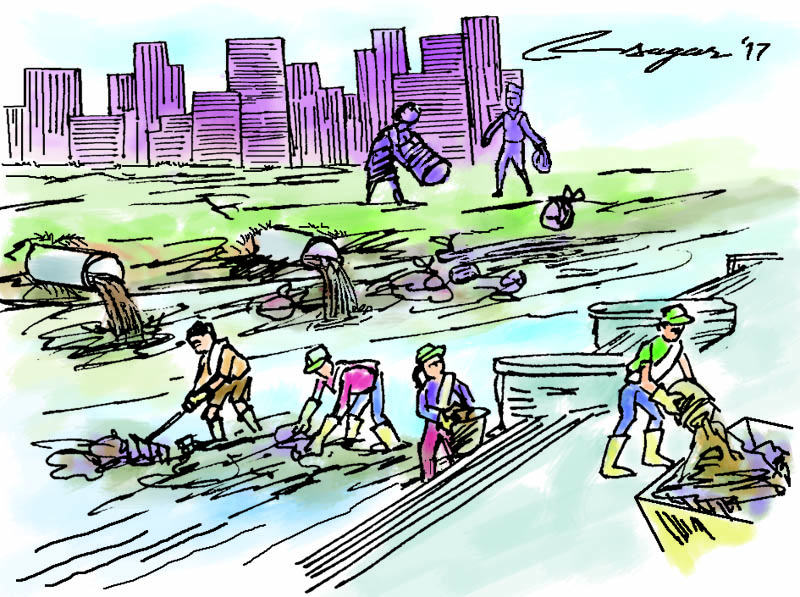Cleaning of Bagmati: More is necessary
The novel cleaning campaign launched and sustained by its promoters is very laudable indeed. But this software, as it may be called should be complemented by the hardware consisting of measures to prevent further dumping of wastage. The cleaning loses meaning if it is alternated by the piling of the garbage
The 200th week of the cleaning of Bagmati River was celebrated amid gala opening with lot of pomp and pleasure which can be understood given the incredible success achieved for its continuity for almost four years now.
It is very unfortunate to see that Bagmati continues to be dirty when it is symbol of holiness for the billion Hindus. It is not only Bagmati but also its major tributaries Bishnumati, Icchumati, Rudramati and Manohara that have been undergoing a similar nightmare.
It has been mentioned in Shrimadbhagwat, a Hindu mythological text that Ganga, the personification of the river was made to descend down to the earth by the sage Bhagirath in order to wash the sin of his ancestors to enable their ascent to heaven. Ganga declined in the beginning for fear of being polluted after flowing in the earth.
But she had to come down as Mahadev, the destroyer, had already given the blessing to Bhagirath for her descent to the earth. Ganga had however said that she would return in due course of time and this has been attributed to the drying of water resources that is taking place at the present.
May it be a myth, but this prophecy of Ganga strangely came to be true first with the rivers of the western world around the nineteenth century. River Thames which flows through the heart of London was so polluted that 1858 was widely known as the great year of the stink.
Cholera outbreaks were quite regular beginning in 1831 and occurring again in 1848 as well as in 1853. Prime Minister Junga Bahadur Rana during his visit in 1850 must have encountered this pollution havoc in England. Michael Faraday, the renowned scientist of that period wrote how Thames had become a virtual sewer.
It was because some 200,000 cesspits and 360 sewers in London either overflowed or they were connected directly to the River Thames. Lawmakers could not function in the newly constructed parliament building and were about to shift it to a new location. Then, queen Victoria and Prince Albert had to abandon a pleasure cruise as they could not withstand the foul odor.
The smooth functioning of the Maternity Hospital of Thapathali and many others located by its bank indicate that the pollution level of Bagmati has not yet degraded to that level. The British Government had become so helpless that an article in one of the leading newspapers commented, “We can colonize remotest point on earth; we can conquer India…….; but we cannot clean the river Thames”. But the pollution was so high that the Parliament finally agreed to sanction a whopping three million pounds in 1858.
The responsibility was given to Joseph Bazalgette who was a Civil Engineer. He had prepared a design consisting of more than thousand miles of underground brick sewers that would intercept the sewage from entering into the Thames. This was coupled with yet another thousand miles of street sewers to accommodate the flowing sewers in the street on both sides of the river, north and south.
This was then dumped untreated to the river downstream. Later a treatment plant was constructed and thereby all this sewage was treated instead of directing to the river. After the completion of the construction based on the design of Bazalgette, Thames was restored to its original glory.
The great stink slowly disappeared from the scene and Britishers could finally breathe a sigh of relief. The fishes also made a comeback and Thames is now considered as one of the cleanest of the rivers. Joseph was knighted in 1875 for his contribution.
The prophecy of Ganga also came to be true in the eastern world. Yamuna River which flows through Delhi is acutely polluted. Luckily, for Bagmati, Bagmati River Basin Improvement is underway. It has multifaceted objectives, one of which is to build sewers down to near Chobhar on both sides of the river as in the case of Thames.
Once this Project is complete, the original glory of Bagmati will be restored. Unfortunately, the work has not yet made a start.
Some recent good practices however exist like islands of hope amidst the ocean of despair. The Chinese river Quinhuai was highly polluted but it has now been restored to its original pride through the implementation of Quinhuai River Basin Improvement Project in collaboration with Asian Development Bank.
Something like ten commandment, it carried out ten activities, the most prominent of them being laying out of the sewers ending into the treatment plants.
The novel cleaning campaign launched and sustained by its promoters is very laudable indeed. But this software, as it may be called should be complemented by the hardware consisting of measures to prevent further dumping of wastage. The cleaning loses meaning if it is alternated by the piling of the garbage.
In this context, Nepal Academy of Science and Technology has initiated the conversion of waste plastic to fuelling oil. Similar other measures will bring Bagmati back to its original glory as did its counterparts Thames and Quinhuai.






